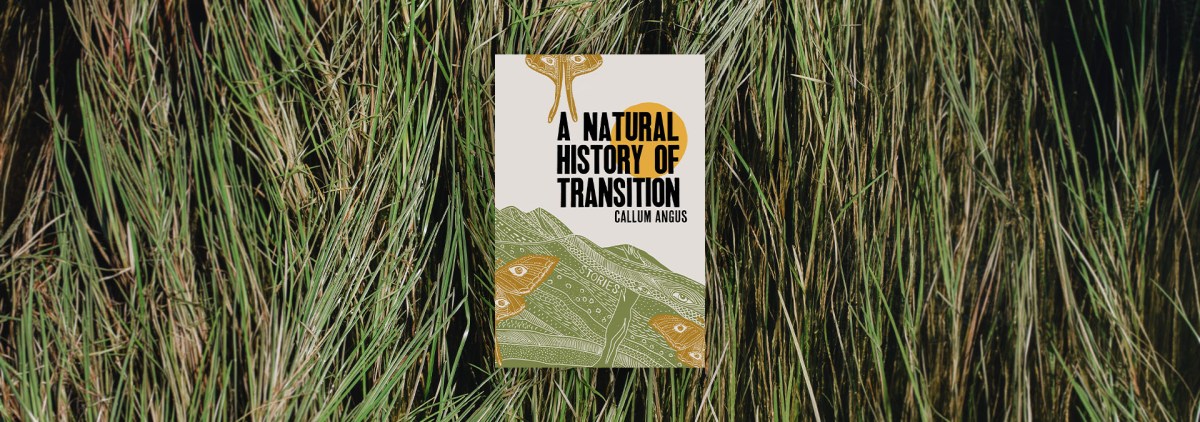[ad_1]
Tell somebody that you’re trans and the egg-hunt begins. The acquaintance that popped in for brunch tries to decipher you, to catalog evidence that indicates transformation. The proof of change could be anywhere though, most noticeably, hiding under your lip or reverberating in your voice, but there are less discernible spots too, things they won’t detect. After all, they’re searching for surgical scars and needle marks, a transition that is merely medical—they don’t know to look for magic.
A Natural History of Transition, the debut story collection from Callum Angus, disrupts the singular, medicalized notions of transition to expose instead the multitudes of transformation, detailing their magical delights, and unwelcome horrors. rans characters fill every story, their bodies birthing cocoons and transforming into mountain ranges, or accompanying a neurodivergent kid coddling his pet caterpillar, Cocksucker. Wherever trans bodies have existed, Callum has no issue placing them there—trailer parks, religious congregations, or rural towns, their stories charting a varied history. While the themes and atmosphere of each story carries a distinct flavor, they all thread together with the magic of transformation.
In the story “Rock Jenny”, a young girl declares to her loving, receptive parents that she would like to be a boy. While her childhood transition goes well, Jenny changes her mind during high school, a drastic shift in and of itself. Sometime later, living with a similarly de-transitioned partner, Jenny undergoes a third, unexpected transformation. Her body begins to balloon day after day, taking up more space, moving outside, until she is a house-sized giantess solidifying into rock. Callum is wonderful at this, offering whimsical narrative interpretations that weave between transition and transformation. Early on, when Jenny is undergoing alarming changes, there is a true sense of urgency and concern in herself and those around her. After all, is turning into a mountain range what she wants? Whether it’s her desire or not seems to be irrelevant though, the process presses onward at breakneck speed; The lack of control both dizzying and uncomfortable. Callum leads us through this uncertain transformation with elegant and effective prose, detailing the natural processes taking over:
“As her naps became longer, small colonies of lichen grew on her back, her thighs, showing up on a zephyr and taking Jenny over until she was covered in scales of blue and gray, like stone from the old rock walls that ran across the property.”
Given the image of Jenny’s body hosting lichens, the tone takes a turn. Where a moment ago it could have felt like the lichen were an encroaching enemy, they are now more akin to a comforting blanket naturally draping over her. Fear and uncertainty become quelled. The elements of nature in Callum’s stories deliver brilliant visuals like these, but they also often illuminate the inherent beauty of transition along with its uncertainties.
A Natural History of Transition continues with this brilliance throughout, abundant in queer mischief that subverts the reader’s expectations of transformation while playfully diving into the unknown. Not all of these turns are as whimsical and reassuring as this though. Some transformations and forms stir a definite dread, or even resounding horror. In the story “The Swarm,” we follow a young sentient swarm composed of grasshoppers, dragonflies, mayflies and locusts. Though the piece remains brief, only a few pages, the impression is unmistakably permanent. As we watch the swarm grow, their parents grumble at the table when the cicadas emerge from their pubescent child. Despite the inherent panic, itchiness, and terror at the hormonal, screaming mass of species that is the swarm, Callum brings a bit of levity, even a bit of normalcy to an unorthodox means of existence; at the dinner table, the mother scoffs back at her young, cicada howling swarm: “Just because you can only get off every seventeen years doesn’t mean all of us have to suffer.”
The best stories in the collection are fantastical and exploratory, giving little explanation of their magical happenings. The morphing bodies and mysterious births all simply offer themselves up, free of sticky simplifications and open instead to a wealth of possibilities. Some readers may take issue with the pointed lack of answers, but through this ambiguity, Callum has crafted a truly explorative experience. The journey into alternate histories, enchanted possibilities, and unexplainable metamorphoses offer their own answers, sometimes to questions you didn’t ask. When people ask me to explain myself, to decipher my trans body—the one currently absent of hormone injections and surgical scars—I want to give them this, a text that reshapes the history of trans bodies into one of endless transformation, not inherently ‘natural,’ but delivered by nature through the lens of magic.
In “Rock Jenny,” Jenny’s mother, a geologist, at one point curiously wonders what kind of rock she is. Now that gender and other labels are inconsequential to her form, debating between igneous and metamorphic seems appropriate enough. Jenny’s mother ultimately offers a third option. Instead of choosing igneous or metamorphic, the two binary options brought up during the initial exchange, she concludes that Jenny is undoubtedly sedimentary. After all, she is an amalgamation of layers so vast that she has become something else entirely. “Just like she wanted.” Her mother replies.
Progressing through the collection, the sediment of every trans character builds in richness; layers of queer history pile up, jagged and dense. The accumulated layers reveal an intimate cross section—each story a marvelous sample, filled with the glittering gradation of transition.

FICTION
A Natural History of Transition
By Callum Angus
Metonymy Press
Published April 27, 2021

[ad_2]
Source link
